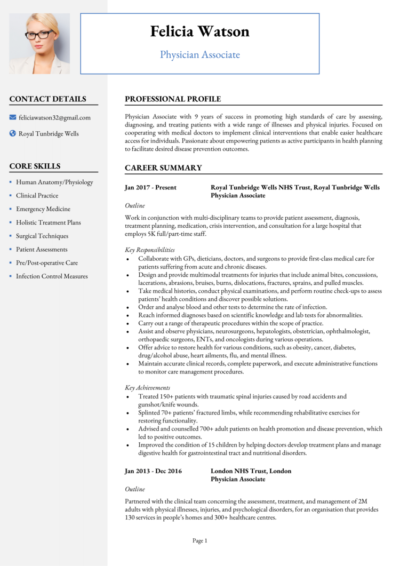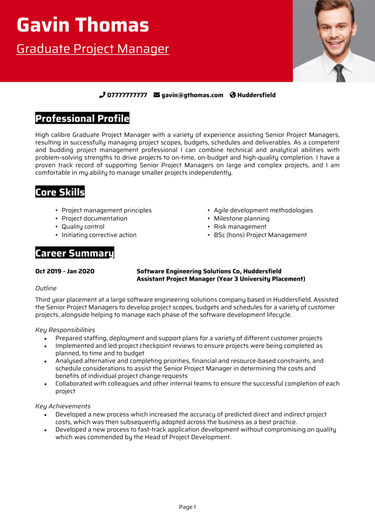The role of a Physician Associate is fast-paced and hands-on – and with rising demand for your skills, competition can be just as high as the patient load. To secure the best roles in hospitals, clinics, or general practice, your CV needs to showcase more than just your clinical knowledge.
This guide (with a Physician Associate CV example) will help you produce a clear, confident CV that highlights your diagnostic skills and ability to provide high-quality care under pressure, to help land you more interviews and rewarding roles.
Physician Associate CV
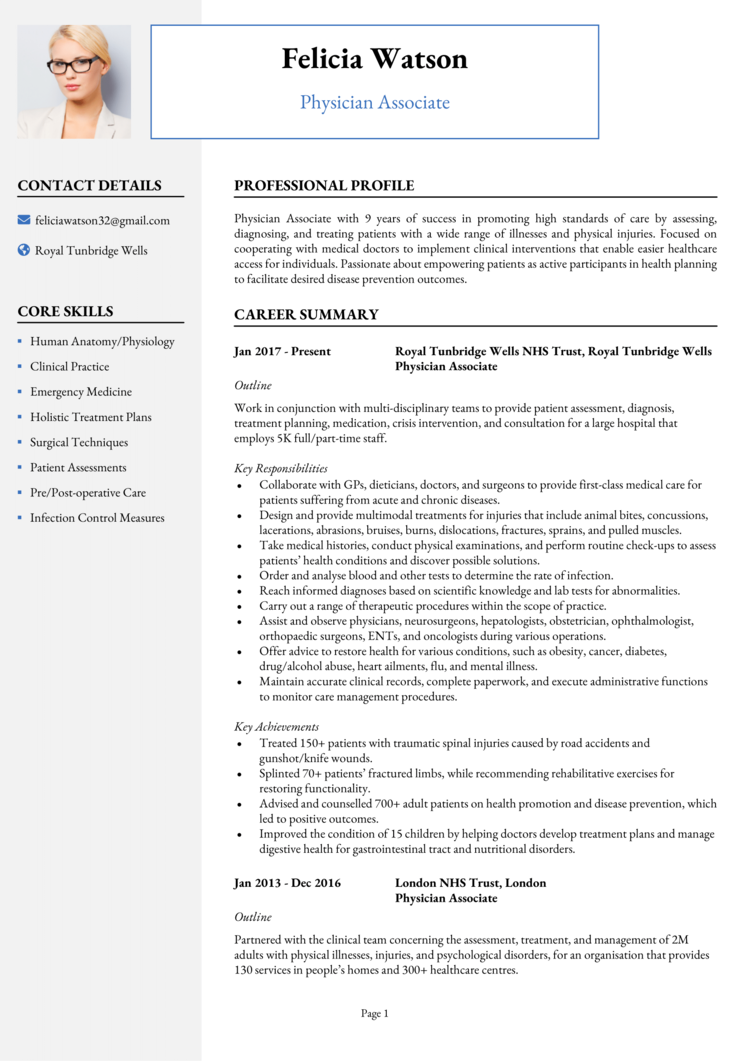
How to write your Physician Associate CV
Discover how to craft a winning Physician Associate CV that lands interviews with this simple step-by-step guide.
Physician Associates are essential in today’s healthcare system to support doctors and ensure continuity of care. But to land the right position, you need a CV that reflects both your competence and your collaborative mindset.
This guide will walk you through the process of writing a CV that captures your clinical strengths and hands-on experience – so hiring managers can easily see the value you bring to the table.
What’s the right way to structure and format your Physician Associate CV?
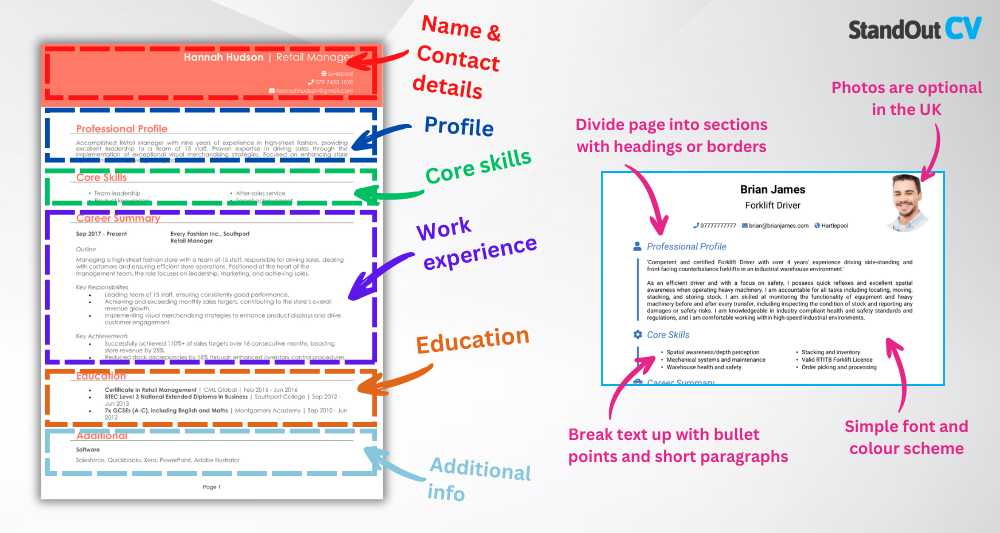
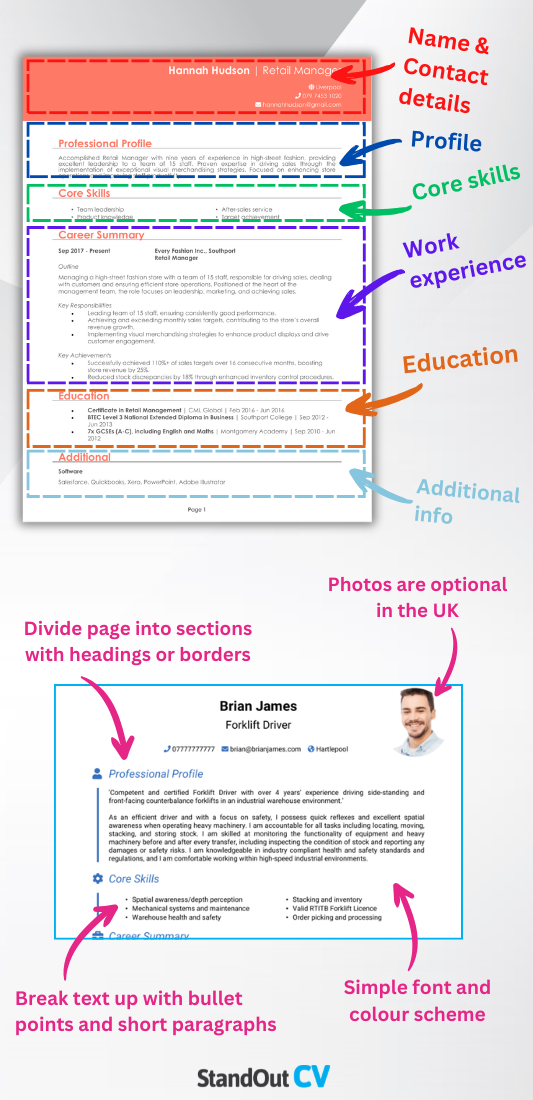
In clinical practice, clarity saves time – and your CV structure should reflect that same level of organisation. A well-structured document allows employers to quickly understand your qualifications and practical experience without digging through fluff or encountering mistakes.
Here’s the layout to follow:
- Name and contact details – Start with your name and personal details – make it simple for recruiters to reach you. Including a photo is a personal choice.
- Profile – Offer a short summary of your clinical focus, qualifications, and career goals.
- Core skills – Bullet point key strengths relevant to your chosen setting or specialty.
- Work experience – Include hospital rotations, placements, and professional roles in reverse chronological order.
- Education & certifications – List your PA qualification, degree(s), and regulatory credentials.
- Additional info – Optionally include languages, hobbies, professional memberships, and any awards.
Use bullet points for readability, divide sections with clear headings, keep the font clean and professional, and limit your CV to two pages in length. Following these tips will ensure a clear format which reinforces your ability to communicate complex information quickly and accurately.
How to create a Physician Associate CV profile
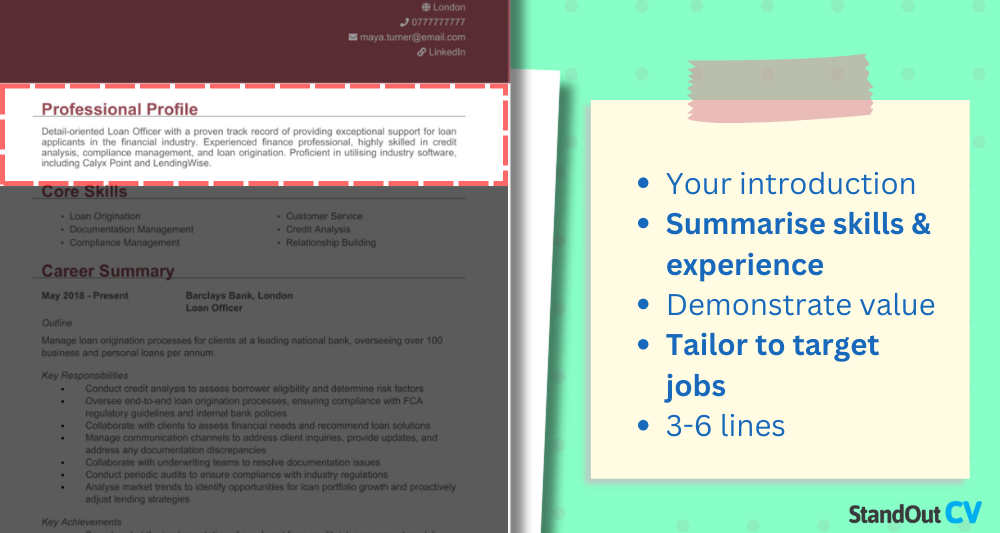
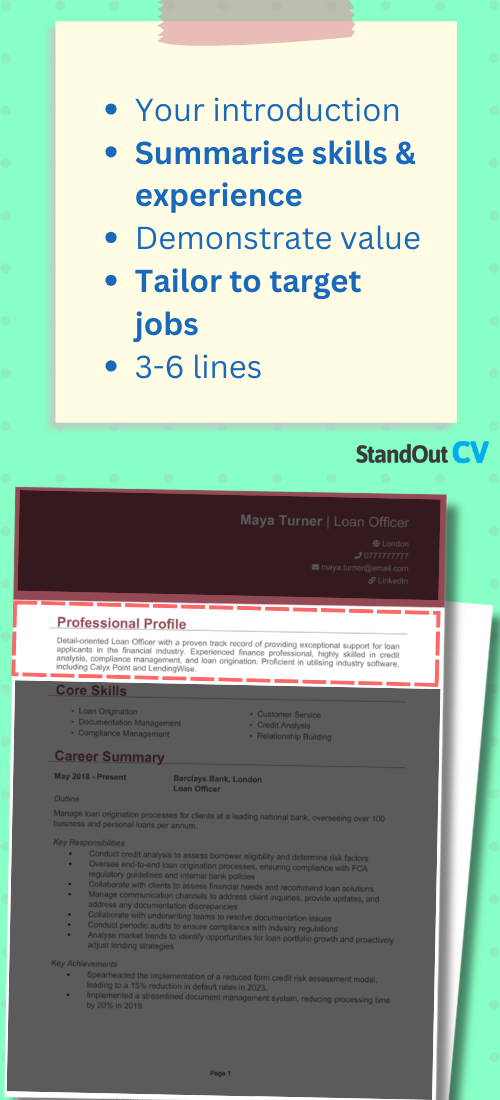
Your CV profile should be a concise overview that highlights your training, clinical interests, and the value you bring to a healthcare team. It’s your first chance to reassure a recruiter that you can work effectively under supervision, provide safe care, and adapt to busy medical environments.
Physician Associate CV profile examples
Profile 1
Motivated and clinically skilled Physician Associate with two years of experience supporting diagnosis, treatment, and patient management in hospital and GP settings. Proficient in conducting physical exams, interpreting test results, and developing care plans under the supervision of physicians. Strong communicator with a commitment to patient-centred care and evidence-based practice.
Profile 2
Compassionate Physician Associate with experience across primary care, general medicine, and A&E placements. Skilled in taking medical histories, managing acute conditions, and supporting chronic disease management. Proficient in EMIS and SystmOne. Known for clinical efficiency, empathy, and building positive relationships with patients and multidisciplinary teams.
Profile 3
Reliable and proactive Physician Associate with a background in internal medicine, cardiology, and urgent care. Experienced in performing diagnostic procedures, delivering patient education, and supporting physician-led interventions. Committed to ongoing professional development and contributing to efficient, high-quality healthcare delivery.
Details to put in your Physician Associate CV profile
Here’s what to include:
- Where you’ve worked – Mention hospitals, GP practices, or departments where you’ve gained experience.
- Your top qualifications – Note your MSc in Physician Associate Studies and any healthcare degrees.
- Essential skills – Refer to your diagnostic abilities, teamwork, and understanding of care protocols.
- Experience in varied clinical settings – Include A&E, primary care, or specialty rotations.
- Commitment to patient-centred care – Show how you support patients holistically and communicate effectively.
Presenting your core skills
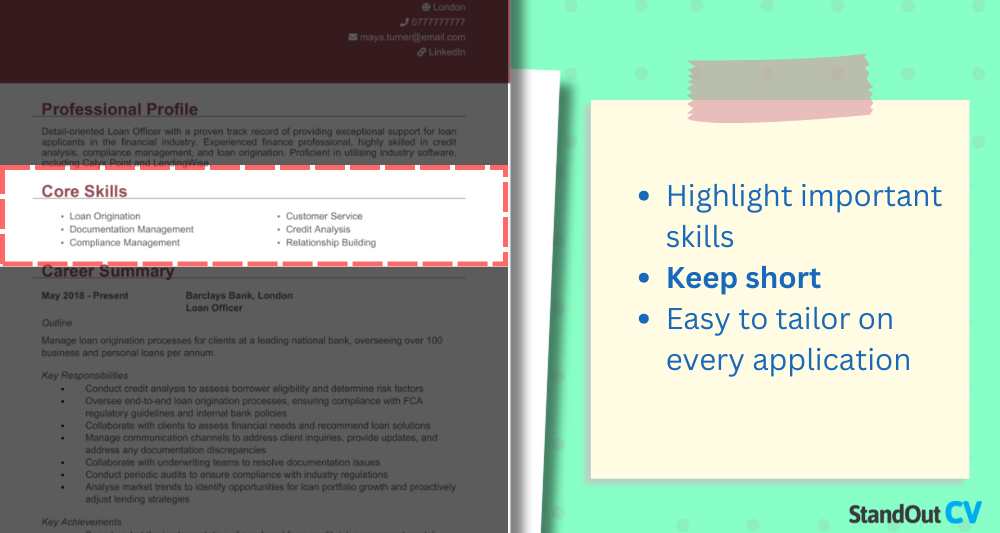

This section provides a quick overview of what you bring to the clinical setting. Rather than listing generic buzzwords, tailor your CV skills to the role you’re applying for. Focus on your ability to perform key procedures, take histories, develop differential diagnoses, and contribute meaningfully to multidisciplinary teams.
Also consider including tech literacy (e.g. with patient records systems) and your areas of specialist interest. The goal is to show you’re not just qualified – but a confident candidate who can do whatever is expected of them.
Essential skills that recruiters look for in a Physician Associate CV
- Clinical Assessment and Diagnosis – Conducting thorough patient histories, physical examinations, and formulating differential diagnoses.
- Patient Management and Treatment Planning – Developing and implementing management plans under the supervision of a consultant or GP.
- Medical Procedures – Performing clinical procedures such as venepuncture, suturing, ECG interpretation, and wound care.
- Diagnostic Investigations – Ordering and interpreting tests including blood work, imaging, and other diagnostics to support clinical decisions.
- Multidisciplinary Team Collaboration – Working closely with doctors, nurses, and allied health professionals to deliver integrated patient care.
- Patient Education and Communication – Explaining diagnoses, treatments, and follow-up care to patients and their families in a clear and empathetic manner.
- Documentation and Clinical Notes – Maintaining accurate, detailed medical records in line with NHS and legal standards.
- Emergency and Acute Care Support – Assisting in urgent care settings, including resuscitation, triage, and initial emergency treatment.
- Clinical Governance and Audit Participation – Contributing to audits, quality improvement initiatives, and evidence-based practice development.
- Continual Professional Development – Engaging in ongoing training and supervision to maintain registration and stay current with medical advancements.
How to highlight work experience
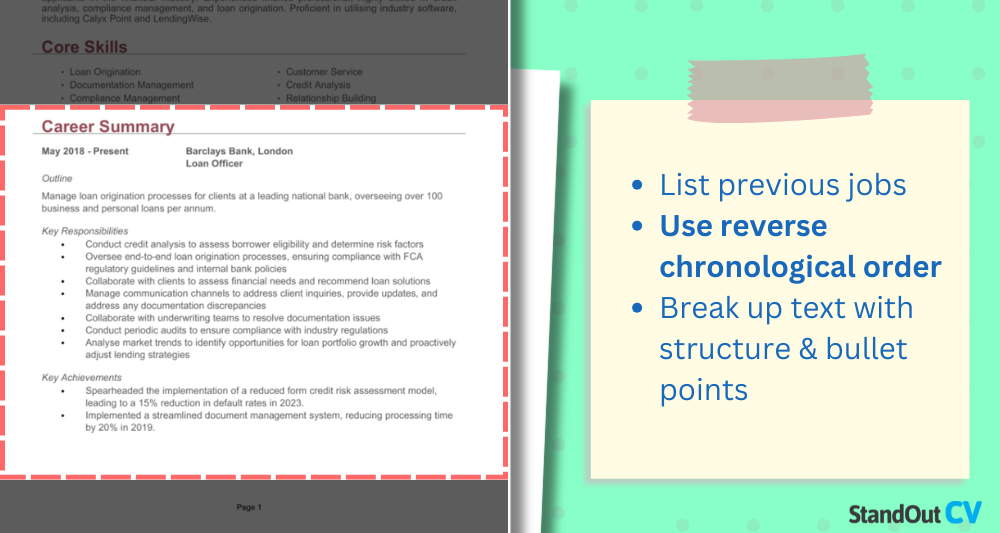
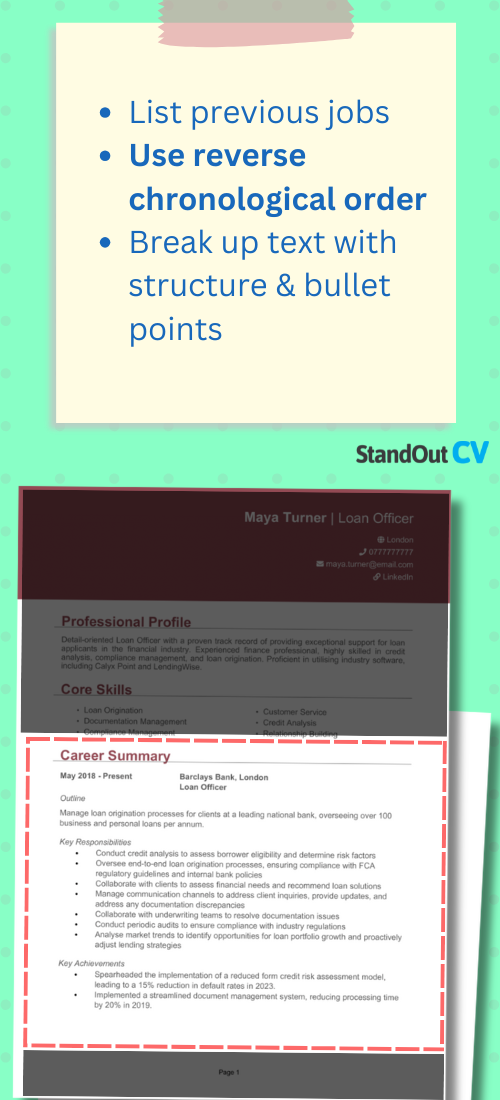
Whether you’ve recently qualified or have years of clinical work experience, this section should reflect the depth and range of your practice. Detail your rotations or placements, but focus especially on the skills developed and the impact you made.
List roles in reverse chronological order. Include the name of the organisation, dates, and your title. Use bullet points to break down duties, highlight any procedures or assessments you performed, and show how you supported both patients and the wider care team.
How to make your past experience easy to read for employers
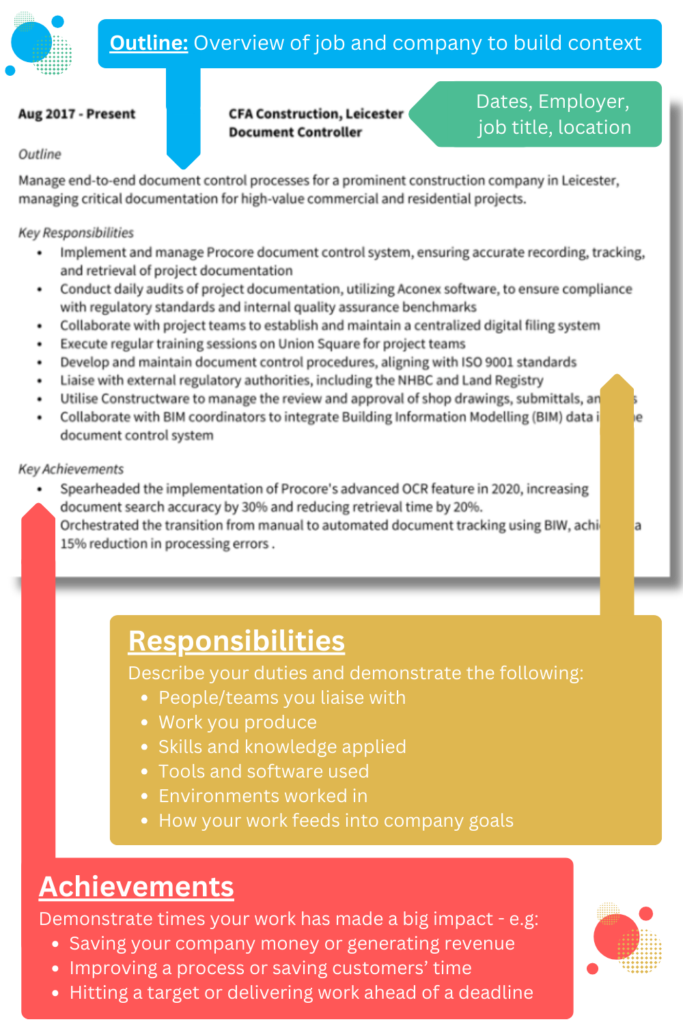
- Outline – Briefly describe the employer and your role in the clinical team.
- Responsibilities – Use action words like “assessed,” “examined,” “diagnosed,” or “co-managed.”
- Achievements – Highlight successes such as “streamlined triage assessments,” or “commended for thorough documentation and handovers.”
Example job entries for Physician Associates
Physician Associate | Harborne GP
Outline
Supported GPs in delivering high-quality care to a diverse patient population within a busy NHS practice, assisting with diagnosis, treatment, and chronic disease reviews.
Responsibilities
- Conducted patient consultations for minor illnesses, following up with physical exams and clinical assessments.
- Took detailed medical histories and ordered appropriate investigations in line with NICE guidelines.
- Supported long-term condition management, including asthma and diabetes reviews.
- Interpreted blood results and imaging, presenting findings to supervising GPs.
- Documented all interactions using EMIS and ensured accurate coding and referrals.
Achievements
- Helped reduce GP workload by managing an average of 25 independent patient appointments per week.
- Received positive feedback from patients for clear explanations and attentive care.
- Contributed to a pilot triage project that improved patient access by 18%.
Physician Associate | Brookvale University Hospital
Outline
Provided clinical support within the general medical team at a large NHS teaching hospital, contributing to diagnosis and ongoing inpatient care.
Responsibilities
- Clerked new admissions, performed clinical examinations, and formulated differential diagnoses.
- Assisted in ward rounds, documenting patient updates and treatment plans.
- Monitored patient progress and liaised with nursing staff and consultants to escalate concerns.
- Requested and interpreted diagnostic tests including ECGs, bloods, and imaging.
- Educated patients and families on diagnoses, procedures, and discharge plans.
Achievements
- Recognised by consultants for thorough documentation and clinical judgement.
- Improved patient flow by independently managing lower-acuity cases during peak admission periods.
- Completed hospital-specific training in venepuncture, cannulation, and NEWS2 scoring.
Physician Associate | Stonemount Urgent Care Centre
Outline
Worked within a multi-disciplinary team to assess and treat walk-in patients presenting with acute symptoms and minor injuries.
Responsibilities
- Assessed and managed conditions such as infections, musculoskeletal injuries, and wound care needs.
- Performed physical assessments and minor procedures including dressings and ECGs.
- Escalated complex cases to emergency services or referred to specialist services as appropriate.
- Maintained accurate and timely documentation using SystmOne.
- Advised patients on medication use, self-care, and follow-up needs.
Achievements
- Managed up to 30 unscheduled patient contacts per shift during high-demand periods.
- Received strong patient feedback for efficiency and clarity during consultations.
- Contributed to a protocol update on red-flag symptom triage.
Education and qualifications
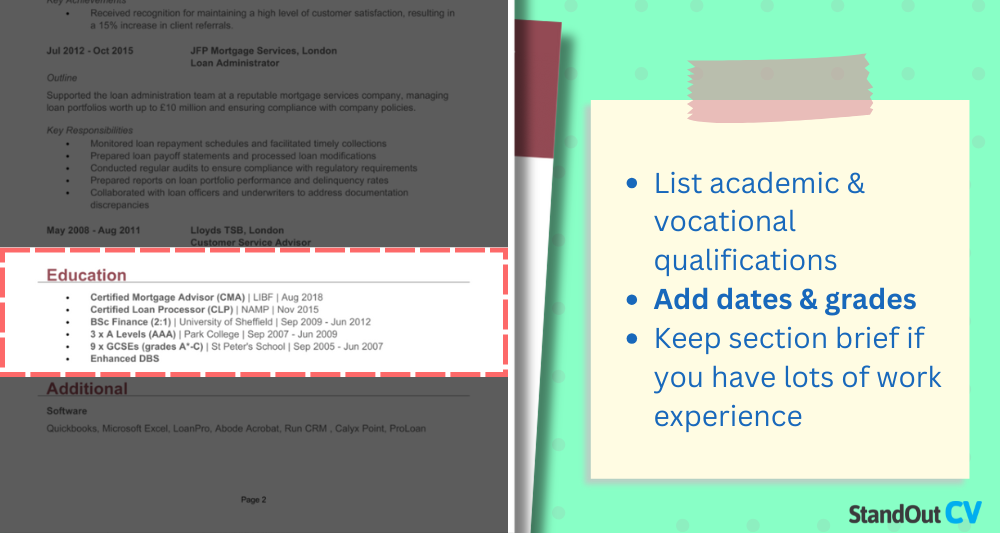

Education is a key part of your credibility. Start with your MSc or PGDip in Physician Associate Studies, followed by your undergraduate degree and any relevant clinical science background. Mention your completion of the UK PA National Examination and registration on the PAMVR (Physician Associate Managed Voluntary Register).
You can also include clinical training certificates, safeguarding, or CPD courses relevant to your role. Make sure you keep this bit pretty short: the focus should remain on your experience.
Qualifications recruiters look for in a Physician Associate
- MSc / PGDip in Physician Associate Studies – Required for all PAs in the UK.
- UK Physician Associate National Certification Exam (PANE) – Must be passed for practice.
- PAMVR Registration – Necessary for recognised roles within the NHS.
- Relevant Undergraduate Degree (e.g. Biomedical Sciences, Health Sciences) – Often a prerequisite for postgraduate study.
- Clinical Skills or Diagnostic Training Certificates (e.g. venepuncture, ECG interpretation) – Enhances your practical capability.


